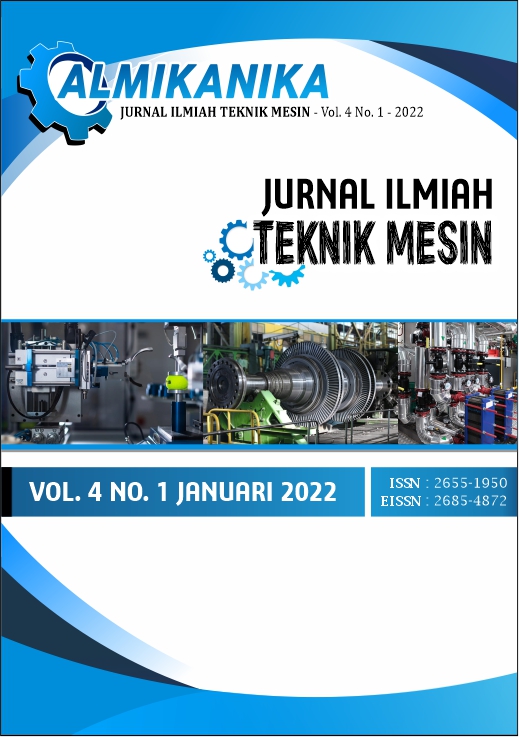Perhitungan Pelepasan Kalor Pada Pipa Bagian Cooler Berdasarkan Perubahan Temperatur Evaporator Di Untai FASSIP-01 MOD.01
DOI:
https://doi.org/10.32832/almikanika.v4i1.7130Kata Kunci:
FASSIP-01, PLTN, RCS.Abstrak
ABSTRAK
FASSIP-01 adalah sebuah piranti analisa pengembangan metode sirkulasi alam yang bertujuan dasar untuk mengedepankan aspek keamanan teknologi struktur PLTN. Ada beberapa komponen pada Untai FASSIP-01 Mod.1 yaitu komponen pemanas yang dinamakan Blankat Ceramick Heater (BCH-02), komponen pendingin dengan Refrigrant Cooling System (RCS), flowmeter untuk sensor aliran dan tabung Ekspansi. Sistem pasif menerapkan hukum alam untuk mengamati kondisi yang tidak stabil pada reaktor. Perlu dilakukannya eksperimen untuk mengetahui karakterisasi distribusi temperatur pada pendingin RCS di Untai FASSIP-01 Mod.1 dengan memvariasikan tekanan dan tegangan 100 volt. pengujian dilakukan selama 1 jam 30 menit dimana pada setiap 15 menit tekanan pada RCS dinaikan dari 1,5 bar sampai 3,0 bar pada valpe di RCS. Hasil eksperimen pada RCS, semakin besar tekanan yang diberikan maka temperaturnya semakin tinggi. Temperatur yang berada didalam section pipe lebih tinggi dibandingkan dengan temperatur dipermukaan section pipe, hal ini disebabkan karena terjadi heat loss pada celah-celah ruang didalam RCS sesudah mencapai pipa section.
Kata kunci : FASSIP-01; PLTN; RCS.
ABSTRACT
FASSIP-01 is a tool for analyzing the development of natural circulation methods with the basic aim of promoting the technological security aspects of nuclear power plant structures. There are several components on the FASSIP-01 Mod.1 Strand, namely heating components called Blankat Ceramick Heater (BCH-02), cooling components with Refrigrant Cooling System (RCS), flowmeter for flow sensors and Expansion tubes. Passive systems apply natural law to observe unstable conditions in the reactor. Experiments are needed to determine the characterization of temperature distribution in RCS coolers in the FASSIP-01 Mod.1 by varying the pressure and voltage of 100 volts. the test was carried out for 1 hour 30 minutes where every 15 minutes the pressure on the RCS was increased from 1.5 bar to 3.0 bar in the valpe in the RCS. The experimental results on the RCS, the greater the pressure given, the higher the temperature. The temperature inside the section pipe is higher than the surface temperature of the section pipe, this is due to heat loss in the space gaps within the RCS after reaching the section pipe.
Keywords : FASSIP-01; PLTN; RCS.
Referensi
J. Lim, S.W. Choi, J. yang, D.Y. Lee, S. Rassame, T. Rassame, T. Hibiki, M. Ishii, Assessment of passive safety system performance undermain steam line break accident, Annals of Nuclear Energy 64 (2014) 287-294.
A.K. Nayak, R.K. Sinha, Role of passive system in advance reactors, Progres in Nuclear Energy 49 (2007) 486-498.
Tiara Indriawati, sistem pertanggung jawaban sipil dalam kecelakaan reaktor nuklir menurut hukum lingkungan internasional, Fakultas Hukum Universitas Andalas
Ade Gafar Abdullah, Zaki Su'ud, analisis kecelakaan reaktor akibat kegagalan sistem pembuang panas pada reaktor nuklir generasi iv, Jurnal Pendidikan Indonesia 8 (2012) 106-114.
Eckhard Krepper, Matthias BeyerForschungszentrum Dresden-Rossendorf e.V., (FZD) Institute of Safety, Experimental and numerical investigations of natural circulation phenomena in passive safety system for decay heat removal in large pools, Nuclear Engineering and design 240 (2010) 3170-3177.
Mingjun Wang, Suizheng Qiu, Wenxi Tian, Guanghui Su, Yapei Zhang, The Comparison of designed water-cooled and passive residul heat removal system for 300 MW nuclear power plant during the feed-water line break scenario, Annals of Nuclear Energy 57 (2013) 164-172.
Muh. Darwis Isnaini, Sukmanto D., Suroso,Geni R. S, Endiah P. Hastuti dan Muh. Subekti, Evaluasi parameter desain temohidrolika teras dan sub kanal PLTN AP1000 pada kondisi tunak, Jurnal Teknologi Reaktor Nuklir Tri Dasa Mega Volume 14, Nomor 1 (2012) 15-31.
Mingjun Wang, Wenxi Tian, Suizheng Qiu, Guanghiu Su, Yapei Zhang, an evalution of designed passive core makeup tank (CMT) for China Pressurized Reactor (CPR1000), Anals of Nuclear Energy 56 (2011) 4504-4514.
Jong-Ho Choi, Jhon Cleveland, Nuset Aksan, Improvement in understanding of natural circulation phenomena in water cooled nuclear power plants, Nuclear Engineering and Design 241 (2011) 4504-451
Unduhan
Diterbitkan
Cara Mengutip
Terbitan
Bagian
Lisensi
- Penulis menyimpan hak cipta dan memberikan jurnal hak penerbitan pertama, dengan pekerjaan [TENTUKAN PERIODE WAKTU] setelah penerbitan secara simultan dengan lisensi di bawah: Creative Commons Attribution License yang memudahkan yang lain untuk berbagi karya dengan penerbitan awal dan kepenulisan karya di jurnal ini.
- bisa memasukkan ke dalam penyusunan kontraktual tambahan terpisah untuk distribusi non-ekslusif versi kaya terbitan jurnal (contoh: mempostingnya ke institusional atau menerbitkannya dalam sebuah buku), dengan penerbitan awal di jurnal ini.
- Penulis menyatakan dan memuji untuk mem-posting karya secara online (contoh: di institusi repositorional atau di situs web) sebelum dan selama proses mereka, karena dapat mengarahkan ke pertukaran produktif, seperti halnya sitiran yang lebih awal dan lebih dari karya yang diterbitkan. (Lihat Efek Akses Terbuka ).


















